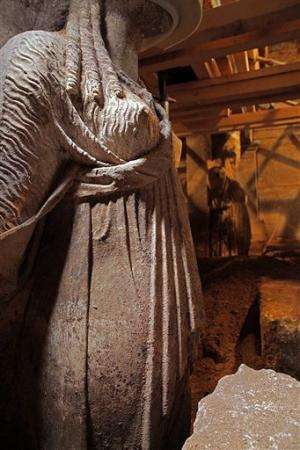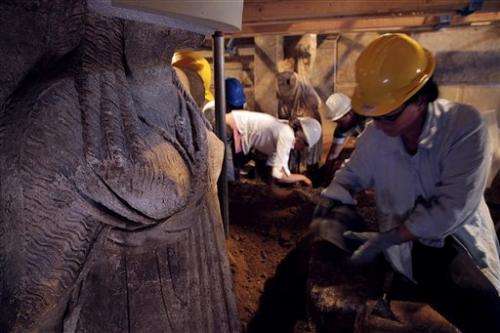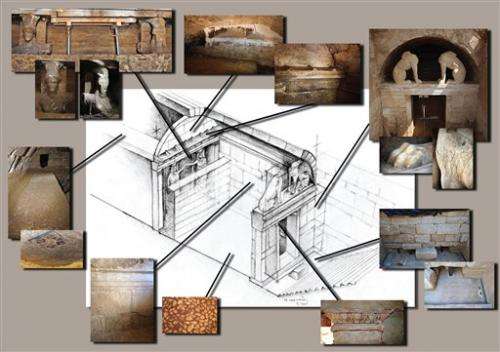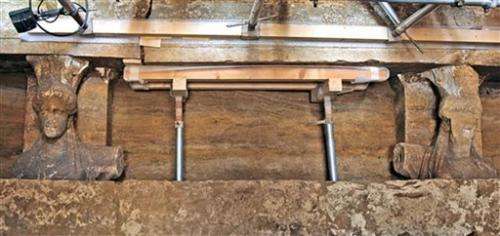Ancient Greek tomb dig finds marble statues

Archaeologists slowly digging through a huge 2,300-year-old tomb in northern Greece have uncovered two life-sized marble female statues flanking the entrance to one of three underground chambers.
A Culture Ministry statement says the statues show "exceptional artistic quality." Their upper sections were discovered last week, but their bodies—in semi-transparent robes—emerged after part of a blocking wall was removed Thursday.
The excavation, on a hillock near ancient Amphipolis, 600 kilometers (370 miles) north of Athens, has gripped Greece for a month, since Prime Minister Antonis Samaras visited it and pre-empted archaeologists by releasing details on the findings.
A media frenzy ensued amid speculation that the tomb may contain buried riches and the remains of an eminent figure.
Less than half the tomb has been explored so far.
-

In this photo released on Thursday, Sept. 11, 2014 by the Greek Culture Ministry, excavation staff work between two approximately life-sized female statues on a wall leading to a yet unexplored inner room of a huge underground ancient tomb, in Amphipolis, northern Greece. The tomb dates between 325 B.C.—two years before the death of ancient Greek warrior-king Alexander the Great—and 300 B.C. Archaeologists have also discovered two large marble sphinxes on the facade of the barrel-vaulted tomb, which was originally topped by a marble lion on a high plinth. It is not yet known who the tomb was built for, although Alexander himself was buried in Egypt. (AP Photo/Culture Ministry) -

This graphic released on Tuesday, Sept. 9, 2014 by the Greek Culture Ministry, shows what Greek archaeologists have unearthed so far, working slowly and laboriously in a vast 4th Century BC underground tomb in Amphipolis, northern Greece, dating from the end of the reign of ancient Greek warrior-king Alexander the Great. Clockwise from top right, the photos show two headless, wingless marble sphinxes above the entrance to the barrel-vaulted tomb - which was originally blocked by a large wall - details of the facade and the lower courses of the blocking wall, the antechamber's mosaic floor, a 4.2-meter long stone slab whose lower surface was painted in blue, red and gold that is the sole survivor of several which originally roofed the first chamber, the upper uncovered sections of two female figures that decorated the wall opening onto the second chamber and was also blocked off, and the highest section of that wall that was found with a hole in its top left-hand corner. The second chamber and a third, not pictured, to the left, have not yet been explored. Archaeologists believe that, despite extensive signs of forced entry during antiquity, the tomb has not been plundered. The structure is 6.5 meters high inside, and was covered by a large earthen mound originally capped by a stone lion statue on a large plinth. There is no indication so far of who it was built for, with theories ranging from a senior military commander of Alexander's to a member of his family. Alexander himself, who died in 323 BC after carving out an empire from modern Greece to India, was buried in the city of Alexandria in Egypt, which he founded. (AP Photo/Culture Ministry) -

This photo released on Sunday, Sept. 7, 2014 by the Greek Culture Ministry, shows 60cm (2 foot) female figurines on a wall leading to the yet unexplored main room of an ancient tomb, in the town of Amphipolis, northern Greece. The tomb dates between 325 B.C.—two years before the death of ancient Greek warrior-king Alexander the Great—and 300 B.C. Archaeologists excavating a massive burial mound in northern Greece have found two marble sculptures of female figures and a large, colored marble panel in what appears to be the antechamber of the main room. (AP Photo/Culture Ministry)
© 2014 The Associated Press. All rights reserved.


















